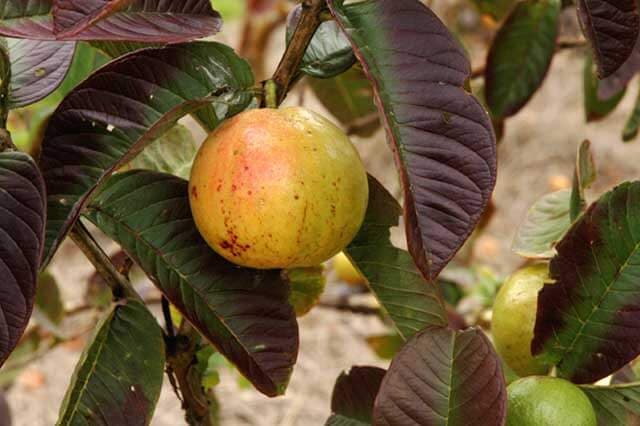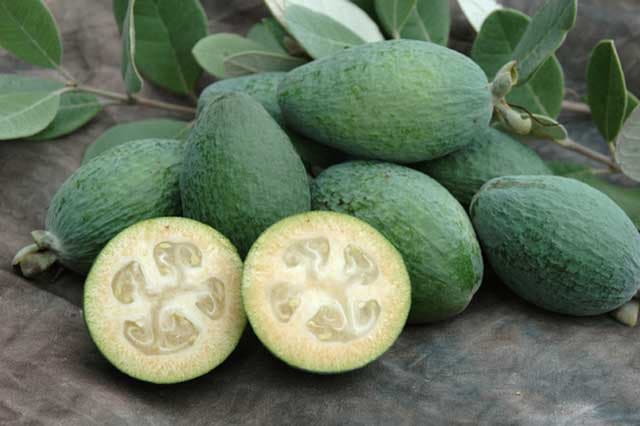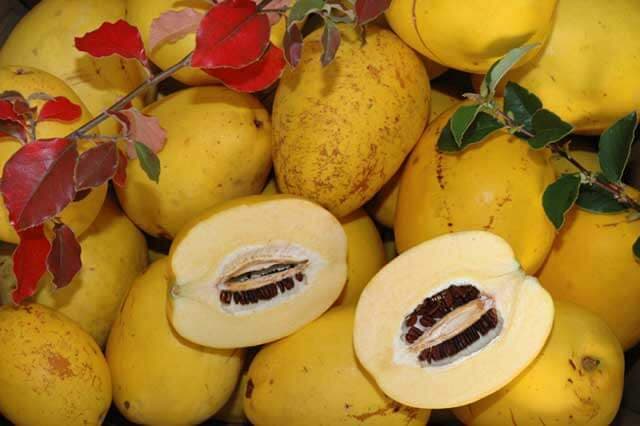
Guava
Psidium guajava
Guavas belong to the Myrtaceae family - a family of flowering myrtle which also includes feijoa, clove and eucalyptus. The guava is native to tropical Central and South America and now grows throughout the tropics and sub-tropics in Africa, South Asia, Southeast Asia, the Caribbean, Spain, Hawaii, New Zealand and Australia. The guava is a hardy evergreen shrub or small tree that grows to a height of two to eight metres. It produces white flowers in January with the fruit maturing in the Summer. The season normally runs from October until December.
Guava fruit is round or pear-shaped and the skin is green, turning to a lime colour and maturing to bright yellow with pink flesh with tiny semi-hard seeds concentrated around the centre.
Guavas are high in dietary fibre, Vitamin C and Magnesium. They also contain several vital minerals, antioxidants and flavonoid compounds. Guavas have an intensely musky, resinous fragrance and aroma and a sour-sweet taste with a granular, pear-like texture. They taste something between a pear and strawberry.
Guavas were originally produced mainly for the canning industry, but emphasis has now shifted to juice extraction. The fresh- fruit market has recently expanded and is now the most important. Guavas are suited to areas with hot summers and cool winters, which makes the Far North suitable for growing guavas.
We have imported the cultivar that best suits the Far North climate and we are the only orchard with this cultivar. We believe we are the only orchard growing guavas commercially in New Zealand and have approx. 800 trees.
Guavas are particularly suited to being poached or stewed. At Dilly Dally, we make Guava Jam, Guava Jelly and Guava Kasundi.

Feijoa
Acca sellowiana
Feijoas belong to the Myrtaceae family - a family of flowering myrtle which also includes guava, clove and eucalyptus. Feijoas are a native of the cool subtropical and tropical highlands of southern Brazil, eastern Uruguay, Paraguay and northern Argentina and Colombia. Cultivation has now spread around the world. They were introduced into New Zealand in the 1920s.
The feijoa is an evergreen shrub or small tree that grows to a height of one to seven metres. It produces an attractive display of red flowers in the late spring and summer. Leaves are green on the upper surface and silver grey on the under side. The fruit are oval or elliptical in shape and approx. 20 to 80mm long with dull green skin. The skin is thin and bitter and generally inedible. Enclosed in the skin is a whitish layer of granular flesh and a central mass of translucent jelly-like pulp containing very small seeds.
Feijoas mature in autumn and the season normally runs from late March until June. Feijoas are a great source of Vitamin C, low in calories and are high in anti-oxidants, fibre, minerals and flavonoids. Feijoas have a very distinctive sweet aromatic flavour with tropical overtones including pineapple and guava - it is also known as 'pineapple guava’. Feijoas are ripe when slightly soft and when the jellied sections of a freshly-cut fruit are clear. Ripe feijoas, unless refrigerated, only retain a good flavour for two to three days. Firm fruit may need two or three days on the bench to fully ripen. Hard fruit will probably never ripen.
We grow a selection of early and late varieties that enable us to make the most of the season. Feijoa is a very versatile fruit used in cakes, muffins, desserts, salsas, sauces, jams, jellies, chutney and wine. At Dilly Dally, we make Feijoa Jam, Feijoa Jelly and Feijoa Chutney.

Quince
Cydonia oblonga
Quinces belong to the Rosaceae family - which also includes apples and pears.
Quinces are native to the rocky slopes and woodland margins of south-west Asia, Turkey and Iran. Quinces are one of the earliest known fruits. Greek mythology associates the quince with Aphrodite, the goddess of love. Ancient Greeks associated the quince with fertility. New Zealand does not have a large commercial producer, but many quince trees are still found in many older home gardens. The trees have a natural tendency to grow in a scraggly fashion.
The quince is a deciduous tree that grows to a height of five to eight metres and to four to six metres wide. Quince is frost hardy and needs a cooler temperature to set the fruit. Quinces mature in autumn and the season normally runs from April until June.
Quinces are high in fibre and are a good source of Vitamin C and the provitamins A, B1 and B2. Quinces have an aromatic spicy fragrance. The fruit is initially bright green and covered in fine fluff. As it ripens it turn pale to golden yellow in colour. Quinces cannot be eaten raw; they are too hard, astringent and tart to eat unless cooked. The tannins that cause the tartness in the raw fruit mellow and turn the fruit red. Cooking softens the flesh and brings out a delightful flavour and aroma. Once cooked, they can be sweetened.
Quinces are high in pectin and therefore are good for making jam, jelly, marmalade, preserves and for stewing and as additions to pies. They are delicious cooked with meats. Quinces can be baked much the same as apples. At Dilly Dally, we make Quince Jam and Quince Jelly.